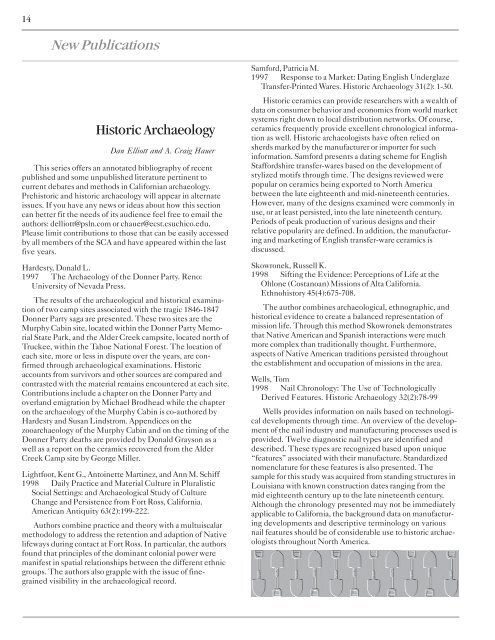March 1999 - Society for California Archaeology
March 1999 - Society for California Archaeology
March 1999 - Society for California Archaeology
You also want an ePaper? Increase the reach of your titles
YUMPU automatically turns print PDFs into web optimized ePapers that Google loves.
14<br />
New Publications<br />
Historic <strong>Archaeology</strong><br />
Dan Elliott and A. Craig Hauer<br />
This series offers an annotated bibliography of recent<br />
published and some unpublished literature pertinent to<br />
current debates and methods in Cali<strong>for</strong>nian archaeology.<br />
Prehistoric and historic archaeology will appear in alternate<br />
issues. If you have any news or ideas about how this section<br />
can better fit the needs of its audience feel free to email the<br />
authors: delliott@psln.com or chauer@ecst.csuchico.edu.<br />
Please limit contributions to those that can be easily accessed<br />
by all members of the SCA and have appeared within the last<br />
five years.<br />
Hardesty, Donald L.<br />
1997 The <strong>Archaeology</strong> of the Donner Party. Reno:<br />
University of Nevada Press.<br />
The results of the archaeological and historical examination<br />
of two camp sites associated with the tragic 1846-1847<br />
Donner Party saga are presented. These two sites are the<br />
Murphy Cabin site, located within the Donner Party Memorial<br />
State Park, and the Alder Creek campsite, located north of<br />
Truckee, within the Tahoe National orest. The location of<br />
each site, more or less in dispute over the years, are confirmed<br />
through archaeological examinations. Historic<br />
accounts from survivors and other sources are compared and<br />
contrasted with the material remains encountered at each site.<br />
Contributions include a chapter on the Donner Party and<br />
overland emigration by Michael Brodhead while the chapter<br />
on the archaeology of the Murphy Cabin is co-authored by<br />
Hardesty and Susan Lindstrom. Appendices on the<br />
zooarchaeology of the Murphy Cabin and on the timing of the<br />
Donner Party deaths are provided by Donald Grayson as a<br />
well as a report on the ceramics recovered from the Alder<br />
Creek Camp site by George Miller.<br />
Lightfoot, Kent G., Antoinette Martinez, and Ann M. Schiff<br />
1998 Daily Practice and Material Culture in Pluralistic<br />
Social Settings: and Archaeological Study of Culture<br />
Change and Persistence from ort Ross, Cali<strong>for</strong>nia.<br />
American Antiquity 63(2):199-222.<br />
Authors combine practice and theory with a multuiscalar<br />
methodology to address the retention and adaption of Native<br />
lifeways during contact at ort Ross. In particular, the authors<br />
found that principles of the dominant colonial power were<br />
manifest in spatial relationships between the different ethnic<br />
groups. The authors also grapple with the issue of finegrained<br />
visibility in the archaeological record.<br />
Sam<strong>for</strong>d, Patricia M.<br />
1997 Response to a Market: Dating English Underglaze<br />
Transfer-Printed Wares. Historic <strong>Archaeology</strong> 31(2): 1-30.<br />
Historic ceramics can provide researchers with a wealth of<br />
data on consumer behavior and economics from world market<br />
systems right down to local distribution networks. Of course,<br />
ceramics frequently provide excellent chronological in<strong>for</strong>mation<br />
as well. Historic archaeologists have often relied on<br />
sherds marked by the manufacturer or importer <strong>for</strong> such<br />
in<strong>for</strong>mation. Sam<strong>for</strong>d presents a dating scheme <strong>for</strong> English<br />
Staf<strong>for</strong>dshire transfer-wares based on the development of<br />
stylized motifs through time. The designs reviewed were<br />
popular on ceramics being exported to North America<br />
between the late eighteenth and mid-nineteenth centuries.<br />
However, many of the designs examined were commonly in<br />
use, or at least persisted, into the late nineteenth century.<br />
Periods of peak production of various designs and their<br />
relative popularity are defined. In addition, the manufacturing<br />
and marketing of English transfer-ware ceramics is<br />
discussed.<br />
Skowronek, Russell K.<br />
1998 Sifting the Evidence: Perceptions of Life at the<br />
Ohlone (Costanoan) Missions of Alta Cali<strong>for</strong>nia.<br />
Ethnohistory 45(4):675-708.<br />
The author combines archaeological, ethnographic, and<br />
historical evidence to create a balanced representation of<br />
mission life. Through this method Skowronek demonstrates<br />
that Native American and Spanish interactions were much<br />
more complex than traditionally thought. urthermore,<br />
aspects of Native American traditions persisted throughout<br />
the establishment and occupation of missions in the area.<br />
Wells, Tom<br />
1998 Nail Chronology: The Use of Technologically<br />
Derived eatures. Historic <strong>Archaeology</strong> 32(2):78-99<br />
Wells provides in<strong>for</strong>mation on nails based on technological<br />
developments through time. An overview of the development<br />
of the nail industry and manufacturing processes used is<br />
provided. Twelve diagnostic nail types are identified and<br />
described. These types are recognized based upon unique<br />
“features” associated with their manufacture. Standardized<br />
nomenclature <strong>for</strong> these features is also presented. The<br />
sample <strong>for</strong> this study was acquired from standing structures in<br />
Louisiana with known construction dates ranging from the<br />
mid eighteenth century up to the late nineteenth century.<br />
Although the chronology presented may not be immediately<br />
applicable to Cali<strong>for</strong>nia, the background data on manufacturing<br />
developments and descriptive terminology on various<br />
nail features should be of considerable use to historic archaeologists<br />
throughout North America.
















